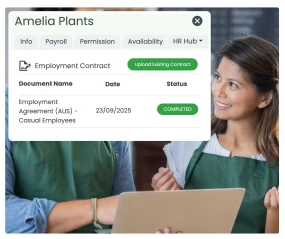In our modern world, companies must manage name and gender changes in workplace records properly. These updates are not just administrative; they represent a significant personal journey for the individuals involved. It's an essential step that can improve mental well-being and job satisfaction. Small and Medium Enterprises (SMEs) may struggle with managing these changes due to limited resources, but creating an environment of inclusivity and respect is vital.
Mishandling these changes can lead to legal issues and negatively impact employee morale and workplace culture. This guide offers useful and understanding techniques for small and medium-sized enterprises (SMEs) to manage these transformations effectively. Doing so ensures compliance with legal requirements and fosters a welcoming and inclusive atmosphere in today's diverse workplaces.
Why Individuals Change Their Names and/or Gender Identifiers

Understanding the reasons behind an employee's decision to change their name or gender identifier is important. These changes often reflect a personal journey and are vital to one’s identity.
Name changes can occur for various reasons, including gender transition or expression, marriage or divorce, cultural reasons, and personal preference.
- For instance, individuals who identify as transgender or non-binary may change their names and gender markers to align with their gender identity.
- Some people may also change their names to reflect their cultural or ethnic heritage better. Changes in marital status can lead to name changes, such as adopting a spouse's surname, reverting to a maiden name, or choosing a new name after a divorce.
- Finally, some people might change their names simply because they want to start a new phase in life or because of personal preference.
Legal and Personal Significance of These Changes for Employees
Legal Recognition: Changing one's name or gender marker on legal documents is an essential step towards being recognised legally as one's true self. This process can vary by location and may involve legal proceedings.
Personal Identity: For transgender and non-binary individuals, this can be a vital part of their transition process.
Validity and Respect: Recognizing and respecting these changes in the workplace can help validate an individual's identity, promote their personal dignity, and contribute to their overall mental well-being.
Impact on Workplace Inclusivity and Diversity

- Creating an Inclusive Workplace: The workplace needs to support team members who are changing their names or gender. This shows that the organisation values and respects individual identity and expression, promotes inclusivity at work, and acknowledges the importance of employee engagement. Staff should feel comfortable in expressing their true selves in the work environment.
- Encouraging Diversity: Companies can create a diverse workplace culture by embracing these changes. This encourages innovation, creativity, and employee satisfaction, which can benefit the company. Recognising and adapting to diverse gender roles and identities plays a crucial role in this process.
- Setting a Positive Example: When companies handle these changes with sensitivity and respect, they set a positive example for everyone in the workplace. This creates a warm and welcoming environment for both current and future employees.
- Legal Obligations: Accommodating name and gender changes is often required by law as it reflects anti-discrimination laws and policies. Therefore, it is important for companies to comply with legal obligations and promote a safe and fair workplace for all.
Legal Framework and Compliance in Australia
In Australia, it is against the law to discriminate against someone based on their gender identity, including changes to their name or gender on work records. This is protected by federal and state laws, including the Sex Discrimination Act 1984 and the Australian Human Rights Commission Act 1986.
Small and medium-sized businesses (SMEs) must also follow the Privacy Act 1988 when handling personal information like name and gender details. It is essential to keep this information confidential.
Failure to comply with these laws can result in fines, legal trouble and harm to the company's reputation. It can also negatively affect the workplace environment, lowering morale and employee retention.
What are the Practical Steps for Updating Work Records
We will discuss the steps that Small and Medium Enterprises (SMEs) should take when updating work records after an employee changes their name and/or gender. Maintaining accuracy and consistency across different systems is essential for legal compliance and plays a vital role in demonstrating respect and support for the employee's identity.
Detailed Guide on Updating Internal Systems
- To ensure that an employee's personal information is up-to-date and accurate, it is important to make changes across various systems within the workplace.
- These changes include updating the employee's name and person’s gender identity in the payroll system and coordinating with the payroll service provider if necessary.
- The employee's email address and display name should be updated in all communication systems used within the organisation to avoid any confusion or errors.
- It is also important to issue new ID badges and access cards with the updated name and gender marker to ensure the employee's comfort and accessibility within the workplace.
- Finally, all other internal systems, like HR databases, project management tools, and internal directories, must be updated to ensure consistency.
Ensuring Consistency Across All Records
Cross-Checking Records: It is important to cross-check the records after updating individual systems. This is to ensure that all records reflect the changes consistently. Failure to do so can lead to confusion and may inadvertently out or misgender the employee.
Training Staff: Relevant staff, especially those in the HR and IT departments, should be trained on maintaining consistency in record-keeping. They need to understand the procedures for updating records and the significance of these changes to the employee’s well-being and identity.
Handling Historical Records and Data Privacy Considerations
When handling historical records, it's important to decide how to proceed. Sometimes, it may be necessary to keep past records under the previous name for legal or compliance reasons. However, ensuring that the employee's privacy is respected throughout this process is crucial.
It's also essential to comply with data privacy laws when making any changes. The employee should give their consent before sharing their previous name and gender with anyone who does not need to know for business or legal reasons.
When communicating these changes to staff who need to be aware, such as managers or team leaders, the emphasis should be on confidentiality and respect for the employee's privacy.
Process of Creating a Supportive Policy

Ensure Clear Objectives: Start by defining the primary goals of the policy, with a focus on inclusivity, respect for individual identity, and legal compliance.
Consult with Legal and HR Professionals: Involve legal advisors to fully understand applicable laws and HR professionals for practical insights into policy implementation.
Draft the Policy: Develop a comprehensive document that outlines procedures for name and gender changes, including steps for requesting changes, timelines, and who is responsible.
Maintain Confidentiality and Privacy: Emphasize the importance of maintaining confidentiality and respecting privacy throughout the process.
Incorporate Feedback Loops: Allow for employee feedback to ensure the policy addresses all concerns and is practical.
Approval and Implementation: Obtain formal approval from senior management and communicate the policy across the organisation.
Provide Staff Training: Conduct training sessions for all staff, highlighting the significance of the policy and educating them on how to adhere to it respectfully and effectively.
Regular Policy Review: Schedule periodic reviews of the policy to incorporate legal updates and feedback, ensuring continuous relevance and effectiveness.
In this guide, we've explained how to update the records of employees in small and medium-sized businesses when they change their name or gender. We've discussed the laws that protect employees, including those related to gender diversity and sexual orientation, how to create policies that support them, and the practical steps to make these updates. This is not just about following the rules but about treating everyone with respect and understanding under the umbrella term of inclusivity. Small and medium-sized businesses need to support these changes and show their commitment to treating all employees with dignity and respect. This kind of commitment creates a positive workplace culture and shows that a business is ethical and cares about its employees, regardless of their gender identity or sexual orientation.
Additional Resources
Transgender Legal Services Network (National Center for Transgender Equality): This network brings together over 80 organisations serving transgender communities to offer advice, technical support, and legal resources. It aims to improve and expand name and gender change services and other legal services for trans people across the country. More information can be found on their website.
Human Rights Campaign - Transitioning in the Workplace: A Guide for Trans Employees: This guide helps transgender people navigate aspects of their transition related to the workplace, including updating personal information and managing workplace dynamics during the transition. The guide is accessible through the Human Rights Campaign website.
Transgender Law Center - Identity Documents Legal and Policy Work: The centre offers resources like guides for changing identity documents in California and federal identity documents, as well as other resources related to name and gender marker changes. For more information, visit their website.
TLDEF - Name Change Project (Transgender Legal Defense And Education Fund, Inc.): This initiative collaborates with law firms and corporate legal departments to offer free legal assistance for changing names to transgender, gender nonconforming, and non-binary individuals who cannot afford it. Visit the TLDEF website for further details.



